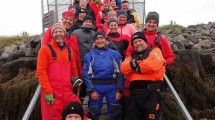Abstract
The ethnography presented by van Eijck and Roth focuses on the activities of people involved in a government funded internship program in conservation and restoration, which was offered by a ‘multidisciplinary research center’ through a local First Nation adult education center. The internship was designed, in partnership with a local non-profit conservation society (OceanHealth), to appeal to First Nation men and women considering career change, returning to school, or re-entering the work place. The primary aim of the internship was to ‘provide authentic science for diverse student populations (and their teachers), with particular attention to the needs of students from First Nations, to become scientifically literate to the extent that it prepares them for participating in public debates, community decision-making, and personal living consistent with long-term environmentally sustainable forms of life’. The authors report that at least one of the two interns was not interested in science and a WSÁNEC elder expressed dissatisfaction with the efforts to establish the nature park and its current approved uses. Van Eijck and Roth argue that the divergence between the project aims and the goals of the participants are a result of how ‘place’ is viewed in place-based education and that disagreements like these can be resolved if place is theorized as chronotope. There are many interesting ideas raised and directions taken in the article by van Eijck and Roth. After several discussions during the review process, we decided to focus our forum response on the meaning of ‘place’ in place-based education, the utility of theorizing place as a chronotope, the implications for teaching–learning (‘education’), and musings on what remains unclear.

Similar content being viewed by others
References
Bakhtin, M. M. (1981). The dialogic imagination: Four essays (C. Emerson & M. Holquist, Trans.). Austin, TX: University of Texas Press.
Engeström, Y. (1999). Activity theory and individual and social transformation. In Y. Engeström, R. Miettinen, & R. Punamaki (Eds.), Perspectives on activity theory (pp. 19–38). Cambridge: Cambridge University.
Freire, P. (1973). Education for critical consciousness (M. B. Ramos, Trans.). New York: Continuum (original work published 1969).
Lefebvre, H. (1991). The production of space (D. Nicholson-Smith, Trans.). Malden, MA: Blackwell (original work published 1974).
Noe, A. (2009). Out of our heads: Why you are not your brain, and other lessons from the biology of consciousness. New York: Hill and Wang.
Shields, C. M. (2007). Bakhtin. New York: Peter Lang.
Sobel, D. (2004). Place-based education: Connecting classrooms & communities. Great Barrington, MA: The Orion Society.
Stetsenko, A. (2005). Activity as object related: Resolving the dichotomy of individual and collective planes of activity. Mind, Culture, and Activity, 12, 70–88.
Stetsenko, A. (2008). From relational ontology to transformative activist stance on development and learning: Expanding Vygotsky’s (CHAT) project. Cultural Studies of Science Education, 3, 471–491. doi:10.1007/s11422-008-9111-3.
Stetsenko, A. (2009). Personhood: An activist project of historical becoming through collaborative pursuits of social transformation. New Ideas in Psychology. http://www.sciencedirect.com/science/journal/0732118X (corrected proof accessed Jan 24, 2010). doi:10.1016/j.newideapsych.2009.11.008.
Stetsenko, A. (2010). Teaching-learning and development as activist projects of historical becoming: Expanding Vygotsky’s approach to pedagogy. Pedagogies: An International Journal (Special issue on Vygotskian approaches to pedagogy edited by W.-W. Roth and Y.-J. Lee), 5(1), 6–16. doi:10.1080/15544800903406266.
Acknowledgments
We would like to thank Anna Stetsenko for sharing her manuscript pre-publication and for introducing us to Henre Lefebvre. We also thank Moshe Sadofsky for fruitful discussions about our interpretations and comments on late drafts of the manuscript, but any faults are ours alone.
Author information
Authors and Affiliations
Corresponding author
Additional information
This is a review essay of: van Eijck, M., & Roth W.-M. Towards a chronotopic theory of “place” in place-based education. Cultural Studies of Science Education
Rights and permissions
About this article
Cite this article
Coughlin, C.A., Kirch, S.A. Place-based education: a transformative activist stance. Cult Stud of Sci Educ 5, 911–921 (2010). https://doi.org/10.1007/s11422-010-9290-6
Received:
Accepted:
Published:
Issue Date:
DOI: https://doi.org/10.1007/s11422-010-9290-6




